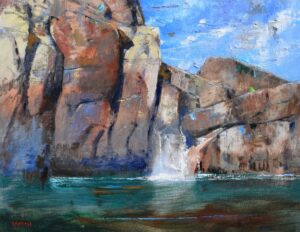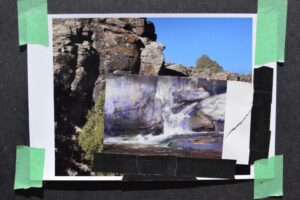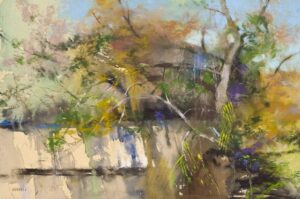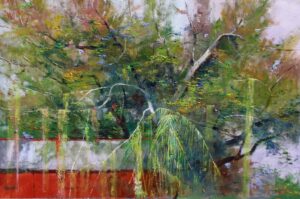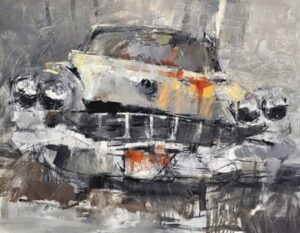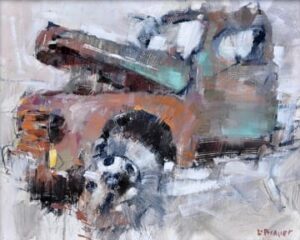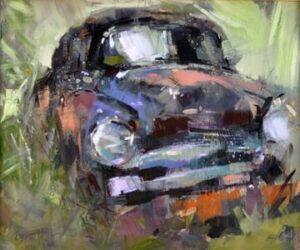
When I started this journey of being an artist, I didn’t realize how many different kinds of artists or artist markets exist. I am not talking about styles of art, realism verse abstractionism or folk verses traditional. I mean artists who focus on local/regional content only, those who are driven by social/political issues, those who seek to be nationally or internationally connected, those who produce work only for its aesthetic beauty, those who are driven by cultural/ethnic content, those who seek out new and innovative approaches and cutting-edge techniques, those who just want to paint whatever comes their way, etc. I struggle, as most artists do, with identifying what, which market I want to be a part of. So I ask myself the question what kind of artist do I want to be and what unique contribution can I make to the field?
Do I want to be a portrait painter, a landscape artist, or an equine painter, consistently producing the same kind of artwork, using the same media in the same style? As I looked closer at art history, I realized that famous and not so famous artists did not stick to one subject matter, one style or one media. Pablo Picasso, for example, painted all kinds of subject matters, worked with clay, created etchings, made sculptures, and produced drawings. According to The Art Story.org “Picasso had an eclectic attitude to style, and although, at any one time, his work was usually characterized by a single dominant approach, he often moved interchangeably between different styles – sometimes even in the same artwork.” Yet consistency is supposed to be the hallmark of an artist work.

If we continue with the example of Picasso, we see that over a lifetime he was anything but consistent. He was, however, consistent during certain time periods. Thus we can identify his Rose or his analytical cubism period. However, none of these periods lasted very long, some for two years, others for 10 years. I once read that consistency in artwork is based on six elements; style, palette, subject matter, theme, medium, and presentation, and while you needn’t have all six elements in your work to be consistent your work should exhibit at least three or four of these elements. Perhaps the answer is consistency in a particular body of work and not consistency over a lifetime. Will consistency help you develop a unique contribution to the field?

by Jacqueline Chanda
How exclusive can one be when there are thousands of artists out there striving to be ‘unique’? In Picasso’s case, it was his contribution of seeing form in a different way, cubism. He was influenced by a number of sources, other artists and cultures. And he worked to step away from many of the academic conventions of his time. So even though he was an excellent draftsman and could render in a classical manner, he chose to see things differently. So ‘unique contribution’ is important if your interest is in transforming the field, turning it on its ears. But what if you just want to paint, what could be your unique contribution? Could it be theoretical exploration, a new way of visualizing an idea or notion, a different way of developing a composition, etc.? While these are all interesting concepts, they take lots of time to explore, develop and perfect. Wasn’t it Chuck Close who refused to exhibit his work until he had perfected his technique? But what can an artist do especially if s/he has to eat, make money to buy supplies, support their art habit? Do you ‘go with the flow’ and create work that is trendy so it can sell? Or do you take the time no matter what to explore, to do work that connects the past and feeds the future, to produce work that is truly unique? Which are you?

So now I come back to the questions at hand, what kind of artist do I want to be and what unique contribution can I make to the field? Even though I have selected oil painting as my major medium and figurative art as my content, I enjoy painting birds, horses, still life arrangements, which might include fruit, shoes, candies, bowls, etc., landscapes, and whatever I find appealing. I feel that the skills I use in painting people are applicable to painting landscapes. I might have to work a little harder at landscape painting, but the principles are the same. And what I learn from painting landscapes, especially plein air landscapes, I apply to my figurative work.
As for consistency, I personally find it hard to stay with just one subject matter for consistency sake. So I focus on creating series or bodies of work that allow me to explore different elements of ideas or related subject matter. One series may focus on a particular subject matter and a special palette while another might focus on composition and a theme. What remains most consistent is my medium, oil painting, my style, loose brush strokes, and my theme, people. As an artist who started her journey late in life, I am not sure I have the time to explore the notions of a truly unique contribution to the field of painting because as I said before it takes lots of time to explore, experiment, and just play. Therefore, I have determined, that my unique contribution, while not earth changing, is really about my voice and vision. The scenes I select to paint, my personal vision of what is important in a scene, my unique voice of expressing my subject matter, the internal logic I use in developing my compositions. Do these choices come naturally? No, not necessarily, I am always looking at what other artists past and present have and are doing, how they manned brushstrokes, the color palettes they use, the compositional arrangements they select. I use what I learn from them sparingly, because creativity is, “knowing how to hide your sources.” While this might not change the face of painting within the next century, it is what I enjoy doing. How about you?
Oil Painting
Some Thoughts About Using Photography
This year I was asked what my thoughts are about painting from photographs and if this is a practice I use.
There is much I can write about, and I will start with……. Yes, I paint from photographs.
But the painting does not look like the photograph, yet, there is no painting without the photograph. So what’s happening?
I think the photographs touch something inside of me, which awakens and inspires me…
Usually, when painting from a photo or my monitor, it is in the studio and with oils. I set up the image(s) the night before, then sleep on it, and I’m ready to start the next morning.
Oils – 22″ x 28″
Here is a good example of what I mean when I say my paintings do not look like the photographs, yet with out the photograph there is no painting.
I would like to say more about myself and photography:
I started studying painting when I was 20 at the Art Students League with the late Frank Mason.
Back then the rage in New York City was Abstract Expressionism. Realism was considered dead by the intelligent ones. You were actually considered stupid to want to paint realistically, “don’t you realize it has already been done?” At that time painting realistically was limited and very different from today.
Among us young artists who wanted to paint realistically, we had a false notion which I swallowed completely …. “if you work from a photo you were an illustrator (God forbid), and if you worked from real life you were considered a fine artist, yay!”
For my first 20 years of painting which was in the studio and out on location, I never considered using a photo.
When I returned from Europe I started using black and white photography as I got involved painting Mexican and Guatemalan marketplaces. That was during an eight-month visit to San Miguel de Allende and afterward.
Woodstock, NY (1970-1983)
A few years later I moved to Woodstock. The landscape and the Catskill mountains were breath-taking. Painting on location and exclusively with pastel. Of course, the light would change and be different from when I began, I found I could have painted both light conditions. While taking a short break and viewing other mouth-watering subjects to paint, I felt as if I was a child in a candy store. This caused inner anxiety.
To satisfy my anxiety I started taking slides of subjects I would have painted if I wasn’t already involved. The weather in Woodstock could get nasty. Since taking only slides of something I would have painted if not already committed to a painting… I found myself in my studio viewing these slides, reliving them, they excited and they inspired me, and I found myself starting to paint from them.
Much to my chagrin, the paintings were beautiful.
This caused a lot of confusion and guilt within me which I struggled with for a good many years till finally getting over it. I now use photography for landscape and find it as a great help for painting my oils in the studio, and my workshop demos.
by Albert Handell
WC and Pastel – 12″ x 18″
by Albert Handell
Oil – 24″ x 36″
Live Preppy
Preppy was a term tossed around a few decades ago. It referred to the behavior of someone who went to a preparatory school. Or, it could refer to a logo-laden dress code. The word and the style fell from favor, but I’ve always liked the sound and decided that it could be re-defined and re-cycled for better use. All of us have heard the honored motto, “Be Prepared”. As artists, we must always make an effort to be so. But my new definition means a bit more. I would like for you to consider not just, being prepared, but also living in a state of preparedness. Living preppy.
Here are a few ways an artist can live a preppy life.
Live in a constant state of awareness.
Collect information, file visual data. You never know when some wonderful visual experience might happen to you. Be ready. Be aware that ideas are all around you. Write them down if you don’t have time for a sketch. You may be unhappily surprised if you don’t get into this practice. You’ll have a wonderful idea, see a great motif and believe that you’ll surely remember. But there is so much data attacking all the time that you may not remember. Carrying a small sketchbook, or even a little notebook is such a great habit. I wrote a note last week, “long deep blue morning shadows from tree line silhouetting foreground interest”. That doesn’t sound like much, but it was just the jolt I needed to remember the idea and return to the location at the right time of day.
Stay prepared by keeping your skills sharp.

This seems obvious especially if you are just beginning your artist’s journey. You are at that part of the learning curve where you must practice every skill such as drawing particularly, but also value study, color mixing, and even perspective. But as we advance, we get to a comfort zone, trust in our skill set and stop working to advance. So, you’ll stay just where you are. Drawing improves because you seek to improve it. And even the most gifted artist will tell you that they wish they drew better. Make practice of your skills a part of your life. Those tedious color charts are invaluable. Drawing either on your own, or with a group is one of the best things you can do to advance your art. And draw just for the sake of drawing. You will gain such amazing memory, both mental and physical. Your hand will want to do just the right thing. But it takes some dedication and commitment to keep those skills moving up the ladder.
Your drawing practice doesn’t need to be limited to life drawing. There may be no life group near you. So start a group. Get some artists together and commit to draw on a regular schedule. You could draw each other. You could have a day when you all bring a favorite object. You could go out and have “celebrate tree day.” Just draw.
Prepare before you begin. Solve problems before they exist.
Get into the habit of exploring an idea, a composition before you begin a painting. This can assume many forms and one or several may work for you. These will probably be different for each artist. There are a couple of things I do that help me get closer to success.
When I’m painting, especially en plein air, I always begin with a drawing. It is nothing formal, not even meant to be a good drawing. That’s not my purpose. I’m moving the pencil around, working it out. I’m studying the few basic values, thinking visually. I write on the drawings, make any note that might help. I start the process in the middle of the page and draw out from there, leaving myself plenty of room to change the cropping of the image. At this point, I don’t know the format, whether it will be a square, rectangle, perhaps a long format. That hasn’t been determined. I need to spend a little time with the subject and let that dictate the ratio. This also slows me down and that is a good thing. I notice that I have more failures when I jump in too soon. And I have noticed this in so many artists. We love to get right into the wonderful paint and may find out at an unfortunate later time that the composition is just not quite there. That is no fun and it is so difficult to try to change it in the middle. Why not begin with success? Then you can truly enjoy the painting process with less worry because you’ve nailed the composition. And since you’ve been practicing your drawing, no worries about getting it in correctly. I do these sketches inside as well.

To the left is a typical set-up for me. I always keep these composition drawings close-by as I go through the painting process. A little bungee cord keeps it from falling into the palette. I learned that detail the hard way.
I also love doing tiny color sketches. I may be preparing to attack a new subject or I may be searching for a fresh idea on a subject I’ve done often. Either way, I find it so helpful to take time to do some of these tiny studies. I mark off scraps of canvas, or even paper to the scale that I’m thinking about. I keep these around the studio so I can grab one that will work for a 4:5 ratio or a 3:4 ratio. And then, I may ignore that altogether and just go for a new ratio that suits the subject. These sketches are done very quickly, no detail, no fuss, just the big ideas. They often look more like abstract paintings than the subject I’m about to tackle. But that’s the point. If an idea works in the abstract, it works in every way. And because they are so quickly done, I tend to explore ideas more thoroughly. I do these on a separate day than I’m planning to start the painting. That way, I don’t rush to decide on the composition. I live with it a while, study it. There is such joy and freedom in this type of preparation.

by Joe Anna Arnett
So whether it is pencil sketches, tiny color abstractions, value compositions with markers, being prepared will not only save you from some problematic compositions, but it will advance your journey at a much more rapid pace. That’s right. That’s what I said. Taking the time up front, being prepared will get you to the goal more quickly and with greater success.
The page of composition ideas shown on the right was done in oil on ordinary brown paper, brushed with shellac. I taped off the rectangles in a 4:5 ratio for a later 12” x 16” canvas. The sketches are only about 4” wide. Use a big brush and leave the details out. Several of these will result in paintings later on. This type of exercise, done on a cheap, non-permanent surface, is so liberating. You’ll find that ideas begin to flow.

Oil on mounted linen – 12” x 16”
One of the little sketches developed further.
Think about it when you wake in the morning. What can I do to live preppy today? Take a sketchbook on my walk? Make notes of interesting ideas? Take time to keep my skills at performance level? Make preparatory drawings and studies? Think it out. Prepare and then go for it with great gusto knowing that you are prepared for success.
Nice going, Preppy!
On Craft and Art

Today we live in the midst of a revolution of art the likes of which the world has never seen. Through the overabundance of art instruction and marketing via social media and the internet, great masses of student artists have emerged. Masses of artists created by multitudes of texts, online tutorials and workshops generated to suit the personality of and pocketbook of every enthusiast across the globe.
What has emerged is a condition of academia whereby the burgeoning artist unwittingly believes that there is a magical system of method that will mold them into a master artist. Yet the bulk of students remain students and never advance beyond craft. Although these artists may have completed numerous workshops and tutorials, they struggle to create a meaningful expression because they lack the ability to see with their heart. They have listened closely and diligently followed each process step-by-step but they have not learned to feel and experience their surroundings in order to imbue their work worth a singular personal expression. Without this quality, their art remains craft and exudes only a dry deadness and the viewer is not compelled to become a part of the artist’s world.
Art is not just what you want to paint, it is also and more importantly, what you want to say. The artist must utilize the basic foundations of art as a platform for their emotional response to a landscape, a still life or a portrait. Academia is not a means to an end, but a tool with which the student may sow the seed of opportunity to blossom into greatness.
All too often I witness students copying this or that artist and jumping from technique to technique and workshop to workshop as if they are collecting trading cards. They purchase all the latest easels, brushes and boutique paints advertised by their favorite artists. But all the while they are overlooking the point of the lessons. They never internalize their training and fail to make the processes a part of their individuality; consequently never moving beyond craft.

Great works of art are enduring because the artist has been uncompromising in their approach to express themselves fully through the language of art. They have put their blood, sweat, and soul into their work to the point where the art itself is indistinguishable from who they are and what they want to say. This kind of art speaks to us on a deep, intimate level because it speaks to us from the heart.
I propose that from the beginning of their academic training, students be coached and encouraged to pour out their heart upon the canvas. That with every step of their foundation they learn to experience the beauty that surrounds them in a way that expresses their particular perspective and personality. In this way I believe the student may not arrive at a stand-still or dead-end upon the completion of their training, but that they arrive at the beginning of art. They arrive at a place where they may create an enduring work of art which emanates the glow of their passion for life and their passion for art.
Know Your Subject Well
When I first left the studio to pursue plein air several years ago I would look for a variety of subject. Real variety. In the course of events I might paint a winding road, a lone tree, a bicycle, two old men in a diner, a summer lake at sunset, a tractor in the barn, a cow, a fence row – anything that caught my fancy. I ended up with a lot of mediocre paintings that had nothing to do with each other. My world was already full of mediocre paintings and I certainly didn’t need to add to that pile. They lacked verisimilitude. Veracity. I didn’t know any of my subjects well enough to communicate my vision.

In my former life as a studio photographer I created reality from pretty much nothing every single day. I once had a client come to me saying he needed an image to illustrate a wholesome breakfast. To him this was an oversized muffin and a hot cup of joe. This was the 80s and that was pretty much a healthy diet in those days. So I gathered the props and baked up some blueberry muffins. A dozen muffins gave me one very nice example; not perfect but near so. Blueberries everywhere. I sliced it in half, placed it on a white saucer, then laid on a square of butter softened just enough to say piping hot. This was flanked by a fabric napkin (light blue), a diner type butter knife (generic, but proud), a cup of black coffee (very black with a small grouping of bubbles to say ’fresh, fresh, fresh!’) and a check from the waitress marked ‘Thanks, come again, Becky!”
I shot this on 8×10 transparency film, processed the image, and then delivered it to the client. He looked it over and said, ‘Boom! That’s it. Love it! And my favorite thing… the little pile of crumbs on the plate under the muffin. That screams verisimilitude”.
Yes, verisimilitude – the appearance of being true.
Well, the whole thing was dripping with verisimilitude. It had everything that read reality – the right props, the right angle of view, the right amount of selective focus, and the right lighting for a morning sunrise. It had story. He had it right to single out the crumbs because in the end it is the detail that made the illusion hold up. Without those crumbs, it would all have been sterile and certainly less convincing.

That experience has stayed with me and I think of it as I make paintings. To pull off a representational image one needs to have verisimilitude – a judicious and efficient use of details. If there is enough information to allow the viewer to relax and understand the point of view then the artist can play with how that image is presented, and do it with abandon.
Drawing is a big deal; Probably more important than anything else. Without a good foundational drawing representational imagery falls apart and doesn’t hold veracity. No one believes it. A poorly drawn building, or old tractor, etc. can quickly devolve into a cartoon version of itself.
Drawing is mark making that describes how objects fit in space. Line work – thick and thin – can tell the story on shadow and highlight. Edges, real or implied, depend on line. My preliminary drawing is generally loose but heavy on perspective issues. I can move things around easily to get the composition worked out. As the piece develops I come back and re-establish my lines and edges. You know, build the edges, knock ’em down, and rebuild. But that structure, that foundational structure, needs to be there throughout. If I have a painting that just doesn’t work it is almost always because the drawing has no interest or is just flat out wrong.

When I go out into the field I look for the unusual point of view. Everything has perspective whether figure, landscape, or still life and that needs to constantly be heeded in the building of the image. If that perspective is accurately built into the foundation one can hang paint all day long on the thing. Monumentality is all in point of view. Angles – find angles that pull the eye into the composition. And if possible, exaggerate those angles. Stretch the thing and make it dynamic. I look for ways to distort without a noticeable distortion.
I paint a lot of vintage cars these days. I can’t tell you a lick about engines; my brain doesn’t go that way, but I do dearly love the look of an old car, particularly those that have gone to seed. They are such wonderful still life subjects with almost universal appeal. It’s my ‘go-to’ thing to paint.
I recently had a solo show. I wanted a cohesive series of work that would tell a story as well as showcase my interests and vision. So it was cars. I had over 40 plein air paintings of cars. I edited this group down to a manageable number and then fleshed out the rest of the wall space with larger studio paintings done from photos, and field studies. What I came to realize in the course of things was that I was developing a comfort level with my subject that freed me to put more energy in the way I put marks on the page. And that is really my thing, anyway.

I’m a process guy. I came of age when DeKooning, Rauschenberg, and Jasper Johns were still making stuff. Those guys knew how to throw paint and create new ways of seeing art. Put it down, scrape it off, and do it again. Abstract Expressionism is a long way from the direct observation of plein air but the mark making should not be dismissed. If the drawing is sound then the mark making process can run through the clover and give us new ways to see the world in front of us.
The point of all of this is to know your subject. Know it inside and out in the same way you might know a piece of music. Own it with confidence. Your viewer will appreciate it. They won’t know why. They’ll start with a comfort level that keeps them engaged with the image. They’ll get it – and then they’ll want to dive in for the good stuff.
by Lon Brauer
by Lon Brauer
by Lon Brauer
